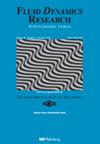Simulation of flow past a squirmer confined in a channel at low Reynolds numbers
IF 1.3
4区 工程技术
Q3 MECHANICS
引用次数: 0
Abstract
Abstract The two-dimensional lattice Boltzmann method was employed to numerically investigate the flow around a circular squirmer in a channel at low Reynolds numbers. The study thoroughly examined the impact of various factors on flow structures and drag coefficients ( C d ) of the squirmer, such as the Reynolds number ( Re ), self-propelled strength ( α ), squirmer-type factor ( β ), blockage ratio ( B ), and orientation angle ( θ ). Notably, despite the low Reynolds numbers, a change in the orientation angle θ resulted in a lift in the squirmer, consequently affecting its lift coefficient ( C l ). The simulation findings underscored that a pair of up-down backflow regions are generated on the squirmer’s surface. Interestingly, the locations of these backflow regions varied significantly between the pusher type ( β < 0), the neutral squirmer ( β = 0), and the puller type ( β > 0). These variations were closely tied to the pressure and velocity distributions on the surfaces of the respective squirmers. Furthermore, an increase in α might induce the formation of a new pair of backflow regions near the channel walls and subsequently elevate the C d . On the other hand, alterations in Re did not affect the flow structures but created a negative correlation with C d . Overall, the study unveiled unique dynamic characteristics, offering a contrast to the extensively investigated case of flow past a cylinder.在低雷诺数条件下流过通道内的涡流的模拟
摘要采用二维点阵玻尔兹曼方法,对低雷诺数通道内环形扭体的流动进行了数值研究。研究深入考察了雷诺数Re、自航强度α、蠕动因子β、堵塞比B、取向角θ等因素对蠕动器流动结构和阻力系数C d的影响。值得注意的是,尽管雷诺数较低,但取向角θ的变化导致了蠕动器的升力,从而影响了其升力系数(c1)。模拟结果强调,在蠕动器表面产生了一对上下回流区域。有趣的是,这些回流区域的位置在推挤型(β <0),中性蠕动器(β = 0),拉拔式(β >这些变化与各自蠕动器表面的压力和速度分布密切相关。此外,α的增加可能导致在通道壁面附近形成一对新的回流区,从而使C d升高。另一方面,Re的变化不影响流动结构,但与cd呈负相关。总的来说,该研究揭示了独特的动态特性,与广泛研究的流过圆柱体的情况形成了对比。
本文章由计算机程序翻译,如有差异,请以英文原文为准。
求助全文
约1分钟内获得全文
求助全文
来源期刊

Fluid Dynamics Research
物理-力学
CiteScore
2.90
自引率
6.70%
发文量
37
审稿时长
5 months
期刊介绍:
Fluid Dynamics Research publishes original and creative works in all fields of fluid dynamics. The scope includes theoretical, numerical and experimental studies that contribute to the fundamental understanding and/or application of fluid phenomena.
 求助内容:
求助内容: 应助结果提醒方式:
应助结果提醒方式:


